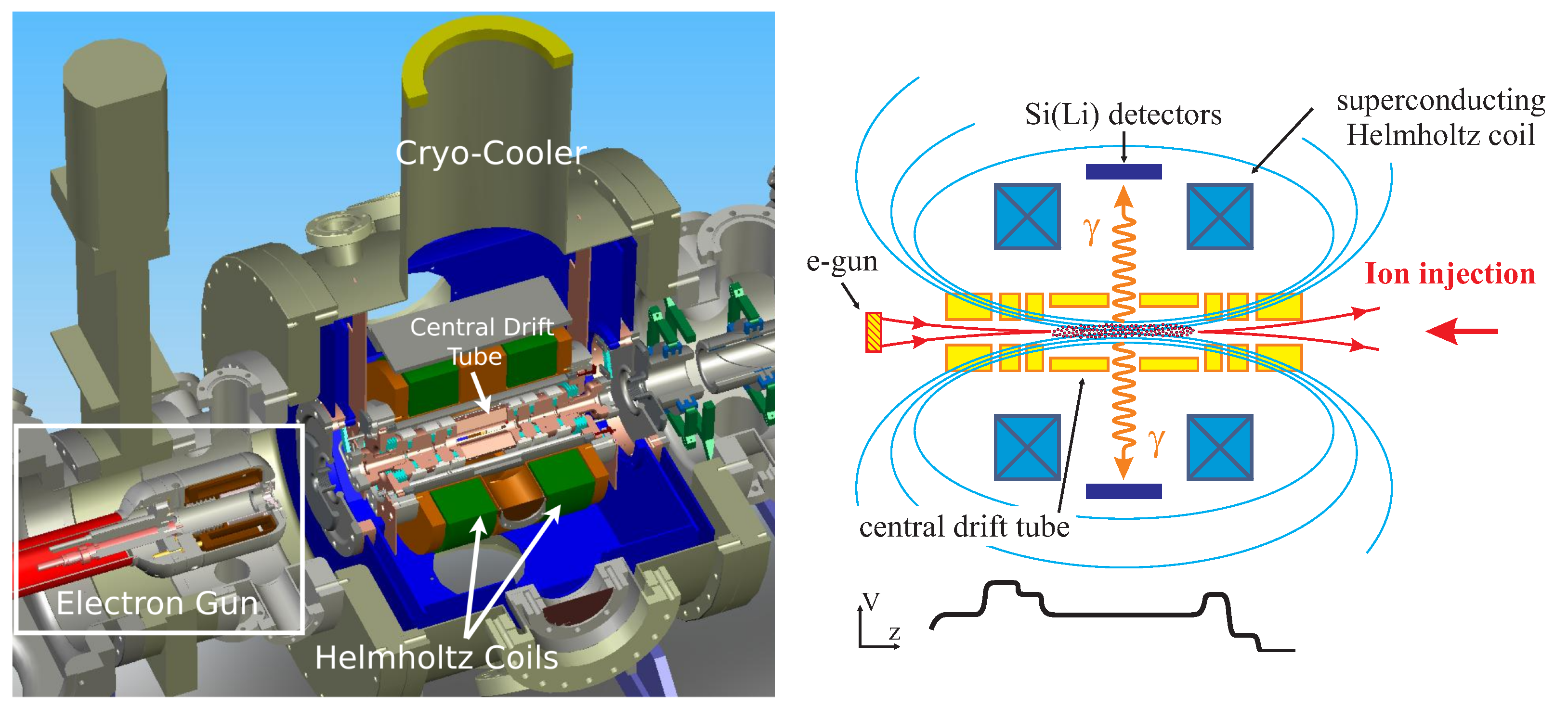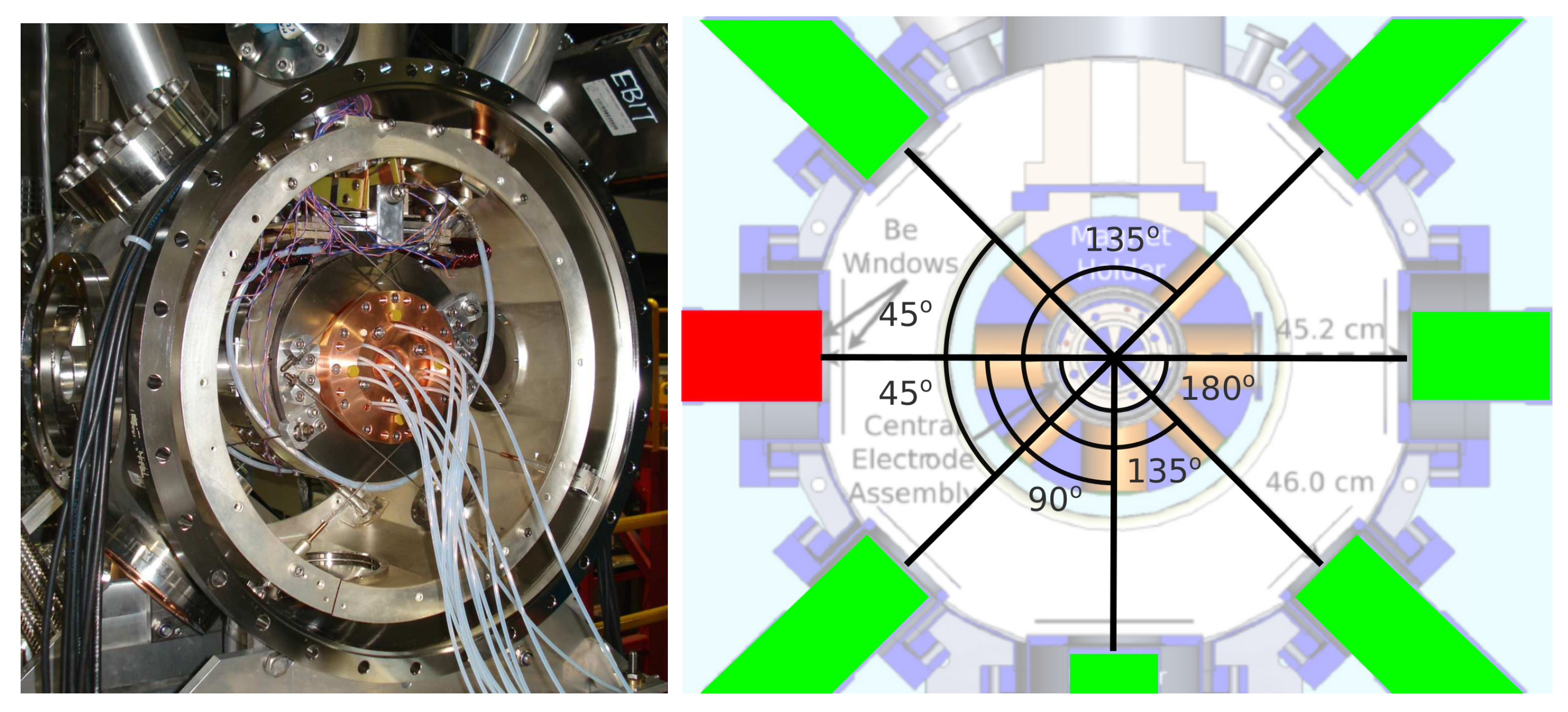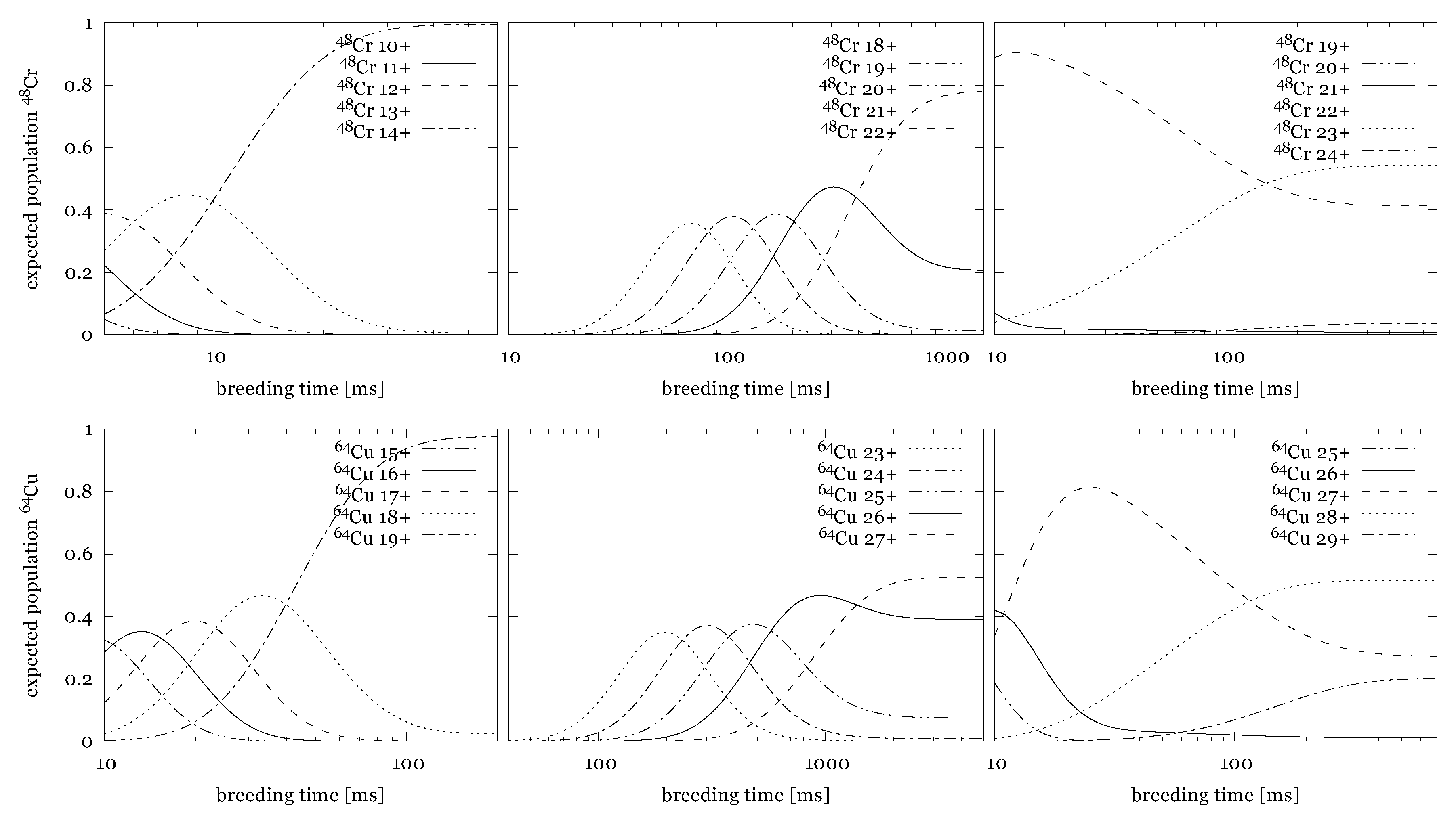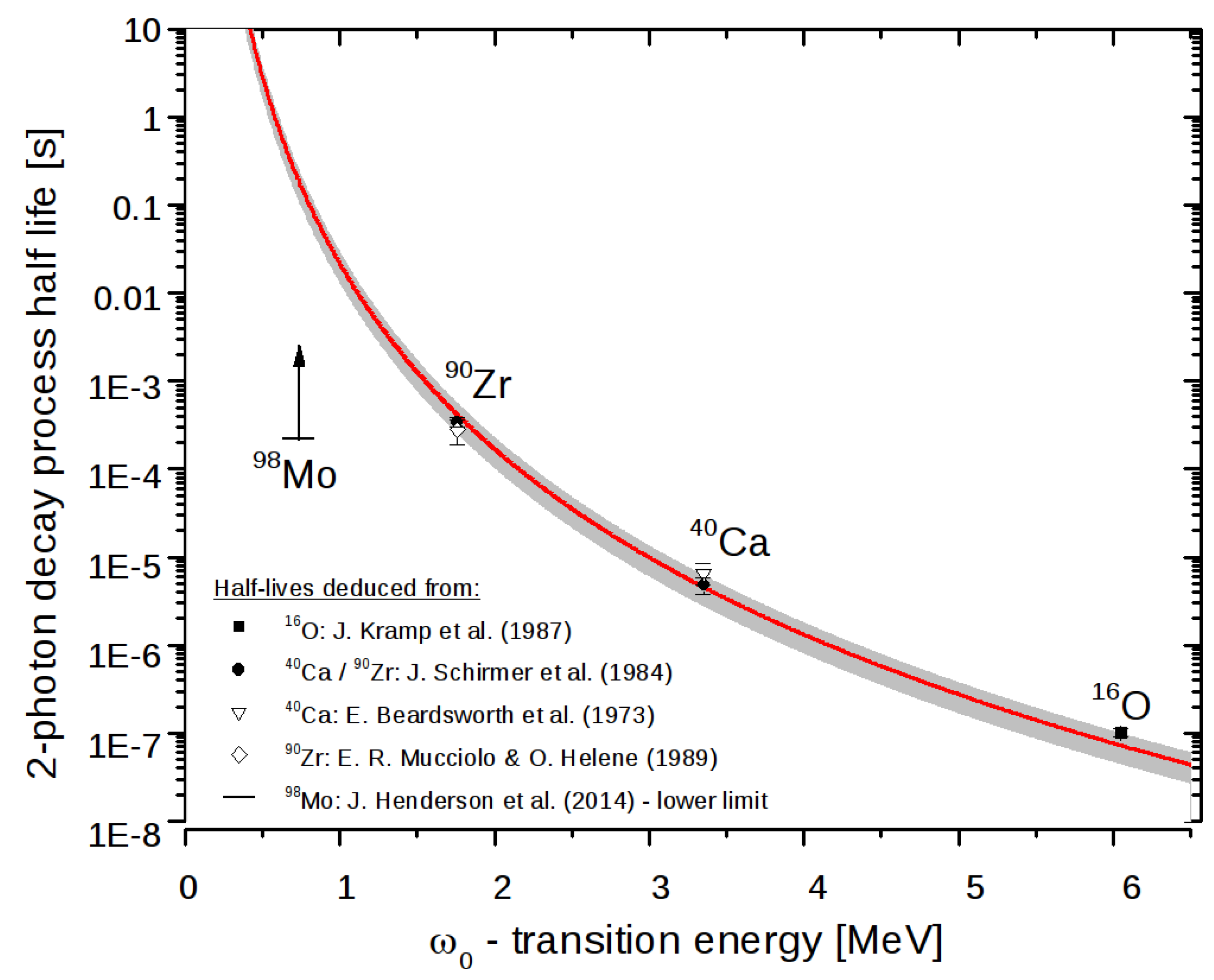Electroweak Decay Studies of Highly Charged Radioactive Ions with TITAN at TRIUMF
Abstract
:1. Introduction
- (1)
- Tests of the electroweak interaction under varying atomic conditions, and
- (2)
- Investigating nucleosynthesis under extreme astrophysical environments which are hot enough to partially or fully strip atoms of their bound electrons.
2. The TITAN Facility at TRIUMF-ISAC
2.1. The TITAN EBIT
2.2. Decay Spectroscopy of HCIs with TITAN
3. Study of HCIs in Astrophysical Scenarios
- No orbital electrons (bare nucleus): the isotope is stable unless free electrons are captured or other decay modes are possible (see Be in the sun).
- One s-electron (H-like state): a single electron in the K shell can be captured. Since only half of the K shell is occupied, the decay half-life should be twice as long.
- Two orbital s-electrons (He-like state): both electrons are in the K shell. The decay rate roughly corresponds to the terrestrial rate, but without contributions from L-shell capture (proportional to ).
Measuring Decay-Rate Changes with TITAN
4. Selective Blocking of Radioactive Decay Modes to Expose Second Order Processes
Experimental Method for Decay in the TITAN EBIT
5. Conclusions
Acknowledgments
Author Contributions
Conflicts of Interest
References
- Krane, K. Introductory Nuclear Physics, 2nd ed.; John Wiley and Sons: New York, NY, USA, 1988. [Google Scholar]
- Litvinov, Y.A.; Bosch, F. Beta decay of highly charged ions. Rep. Prog. Phys. 2011, 74, 016301. [Google Scholar] [CrossRef]
- Bricault, P.; Dombsky, M.; Schmor, P.; Stanford, G. Radioactive ion beams facility at TRIUMF. Nucl. Instrum. Methods Phys. Res. Sect. B Beam Interact. Mater. At. 1997, 126, 231–235. [Google Scholar] [CrossRef]
- Blumenfeld, Y.; Nilsson, T.; Duppen, P.V. Facilities and methods for radioactive ion beam production. Phys. Scr. 2013, 2013, 014023. [Google Scholar] [CrossRef]
- Dilling, J.; Krücken, R. The experimental facilities at ISAC. Hyperfine Interact. 2014, 225, 111–114. [Google Scholar] [CrossRef]
- Dilling, J.; Baartman, R.; Bricault, P.G.; Brodeur, M.; Blomeley, L.; Buchinger, F.; Crawford, J.; Crespo López-Urrutia, J.R.; Delheij, P.; Froese, M.; et al. Mass measurements on highly charged radioactive ions, a new approach to high precision with TITAN. Int. J. Mass Spectrom. 2006, 251, 198–203. [Google Scholar] [CrossRef]
- Smith, M.; Blomeley, L.; Delheij, P.; Dilling, J. First tests of the TITAN digital RFQ beam cooler and buncher. Hyperfine Interact. 2006, 173, 171–180. [Google Scholar] [CrossRef]
- Brodeur, M.; Ryjkov, V.; Brunner, T.; Ettenauer, S.; Gallant, A.; Simon, V.; Smith, M.; Lapierre, A.; Ringle, R.; Delheij, P.; et al. Verifying the accuracy of the TITAN Penning-trap mass spectrometer. Int. J. Mass Spectrom. 2012, 310, 20–31. [Google Scholar] [CrossRef]
- Lapierre, A.; Brodeur, M.; Brunner, T.; Ettenauer, S.; Gallant, A.; Simon, V.; Good, M.; Froese, M.; López-Urrutia, J.C.; Delheij, P.; et al. The TITAN EBIT charge breeder for mass measurements on highly charged short-lived isotopes—First online operation. Nucl. Instrum. Methods Phys. Res. Sect. A Accel. Spectrom. Detect. Assoc. Equip. 2010, 624, 54–64. [Google Scholar] [CrossRef]
- Leach, K.G.; Grossheim, A.; Lennarz, A.; Brunner, T.; López-Urrutia, J.C.; Gallant, A.; Good, M.; Klawitter, R.; Kwiatkowski, A.; Ma, T.; et al. The TITAN in-trap decay spectroscopy facility at TRIUMF. Nucl. Instrum. Methods Phys. Res. Sect. A Accel. Spectrom. Detect. Assoc. Equip. 2015, 780, 91–99. [Google Scholar] [CrossRef]
- Jesch, C.; Dickel, T.; Plaß, W.; Short, D.; Ayet San Andres, S.; Dilling, J.; Geissel, H.; Greiner, F.; Lang, J.; Leach, K.G.; et al. The MR-TOF-MS isobar separator for the TITAN facility at TRIUMF. Hyperfine Interact. 2015, 235, 97–106. [Google Scholar] [CrossRef]
- Simon, V.V.; Chowdhury, U.; Delheij, P.; Dilling, J.; Eberhardt, B.; Gwinner, G. A cooler Penning trap for the TITAN on-line trapping facility. J. Phys. Conf. Ser. 2011, 312, 052024. [Google Scholar] [CrossRef]
- Märk, T.; Dunn, G. Electron Impact Ionization; Springer: Berlin and Heidelberg, Germany, 2013. [Google Scholar]
- Epp, S.W.; López-Urrutia, J.R.C.; Brenner, G.; Mäckel, V.; Mokler, P.H.; Treusch, R.; Kuhlmann, M.; Yurkov, M.V.; Feldhaus, J.; Schneider, J.R.; et al. Soft X-Ray Laser Spectroscopy on Trapped Highly Charged Ions at FLASH. Phys. Rev. Lett. 2007, 98, 183001. [Google Scholar] [CrossRef] [PubMed]
- Frekers, D.; Dilling, J.; Tanihata, I. Electron capture branching ratios for the odd–odd intermediate nuclei in double-beta decay using the TITAN ion trap facility. Can. J. Phys. 2007, 85, 57–75. [Google Scholar] [CrossRef]
- Lennarz, A.; Grossheim, A.; Leach, K.G.; Alanssari, M.; Brunner, T.; Chaudhuri, A.; Chowdhury, U.; Crespo López-Urrutia, J.R.; Gallant, A.T.; Holl, M.; et al. In-Trap Spectroscopy of Charge-Bred Radioactive Ions. Phys. Rev. Lett. 2014, 113, 082502. [Google Scholar] [CrossRef] [PubMed]
- Leach, K.G.; Lennarz, A.; Grossheim, A.; Klawitter, R.; Brunner, T.; Chaudhuri, A.; Chowdhury, U.; López-Urrutia, J.R.C.; Gallant, A.T.; Kwiatkowski, A.A.; et al. Low-Background In-Trap Decay Spectroscopy with TITAN at TRIUMF. In Proceedings of the Conference on Advances in Radioactive Isotope Science, Tokyo, Japan, 1–6 June 2014; Volume 6, p. 020040.
- Bahcall, J.N. Electron Capture and Nuclear Matrix Elements of Be7. Phys. Rev. 1962, 128, 1297–1301. [Google Scholar] [CrossRef]
- Gruzinov, A.V.; Bahcall, J.N. The 7Be Electron Capture Rate in the Sun. Astrophys. J. 1997, 490, 437. [Google Scholar] [CrossRef]
- Adelberger, E.G.; García, A.; Robertson, R.G.H.; Snover, K.A.; Balantekin, A.B.; Heeger, K.; Ramsey-Musolf, M.J.; Bemmerer, D.; Junghans, A.; Bertulani, C.A.; et al. Solar fusion cross sections. II. The pp chain and CNO cycles. Rev. Mod. Phys. 2011, 83, 195–245. [Google Scholar] [CrossRef]
- Simonucci, S.; Taioli, S.; Palmerini, S.; Busso, M. Theoretical Estimates of Stellar e—Captures. I. The Half-life of 7Be in Evolved Stars. Astrophys. J. 2013, 764, 118. [Google Scholar] [CrossRef]
- Stone, E.; Frandsen, A.; Mewaldt, R.; Christian, E.; Margolies, D.; Ormes, J.; Snow, F. The Advanced Composition Explorer. Space Sci. Rev. 1998, 86, 1–22. [Google Scholar] [CrossRef]
- Zaerpoor, K.; Chan, Y.D.; Dragowsky, M.R.; Isaac, M.C.P.; Krane, K.S.; Larimer, R.M.; Macchiavelli, A.O.; Macleod, R.W.; Norman, E.B. Cosmic-ray half-life of 56Ni. Phys. Rev. C 1999, 59, 3393–3396. [Google Scholar] [CrossRef]
- Atanasov, D.R.; Winckler, N.; Balabanski, D.; Batist, L.; Bosch, F.; Boutin, D.; Brandau, C.; Dimopoulou, C.; Essel, H.G.; Faestermann, T.; et al. Half-life measurements of stored fully ionized and hydrogen-like 122 I ions. Eur. Phys. J. A 2012, 48, 22. [Google Scholar] [CrossRef]
- Litvinov, Y.A.; Bosch, F.; Geissel, H.; Kurcewicz, J.; Patyk, Z.; Winckler, N.; Batist, L.; Beckert, K.; Boutin, D.; Brandau, C.; et al. Measurement of the β+ and Orbital Electron-Capture Decay Rates in Fully Ionized, Hydrogenlike, and Heliumlike 140Pr Ions. Phys. Rev. Lett. 2007, 99, 262501. [Google Scholar] [CrossRef]
- Winckler, N.; Geissel, H.; Litvinov, Y.; Beckert, K.; Bosch, F.; Boutin, D.; Brandau, C.; Chen, L.; Dimopoulou, C.; Essel, H.; et al. Orbital electron capture decay of hydrogen- and helium-like 142Pm ions. Phys. Lett. B 2009, 679, 36. [Google Scholar] [CrossRef]
- Patyk, Z.; Kurcewicz, J.; Bosch, F.; Geissel, H.; Litvinov, Y.A.; Pfützner, M. Orbital electron capture decay of hydrogen- and helium-like ions. Phys. Rev. C 2008, 77, 014306. [Google Scholar] [CrossRef]
- Kramp, J.; Habs, D.; Kroth, R.; Music, M.; Schirmer, J.; Schwalm, D.; Broude, C. Nuclear two-photon decay in 0+→0+ transitions. Nucl. Phys. A 1987, 474, 412–450. [Google Scholar] [CrossRef]
- Walz, C.; Scheit, H.; Pietralla, N.; Aumann, T.; Lefol, R. Observation of the competitive double-gamma nuclear decay. Nature 2016, 526, 406–409. [Google Scholar] [CrossRef] [PubMed]
- Tamii, A.; Poltoratska, I.; von Neumann-Cosel, P.; Fujita, Y.; Adachi, T.; Bertulani, C.A.; Carter, J.; Dozono, M.; Fujita, H.; Fujita, K.; et al. Complete Electric Dipole Response and the Neutron Skin in 208Pb. Phys. Rev. Lett. 2011, 107, 062502. [Google Scholar] [CrossRef] [PubMed]
- Hayes, A.C.; Friar, J.L.; Strottman, D. Two-photon decay of the first excited 0+ state in 16O. Phys. Rev. C 1990, 41, 1727–1735. [Google Scholar] [CrossRef]
- Schirmer, J.; Habs, D.; Kroth, R.; Kwong, N.; Schwalm, D.; Zirnbauer, M.; Broude, C. Double Gamma Decay in 40Ca and 90Zr. Phys. Rev. Lett. 1984, 53, 1897–1900. [Google Scholar] [CrossRef]
- Mucciolo, E.R.; Helene, O. Double gamma decay in 90Zr. Phys. Rev. C 1989, 40, 2403–2405. [Google Scholar] [CrossRef]
- Henderson, J.; Jenkins, D.G.; Davies, P.J.; Alcorta, M.; Carpenter, M.P.; Kay, B.P.; Lister, C.J.; Zhu, S. Upper limit on the two-photon emission branch for the → transition in 98Mo. Phys. Rev. C 2014, 89, 064307. [Google Scholar] [CrossRef]
- ENSDF: Evaluated Nuclear Structure Data File Search and Retrieval. Available online: http://www.nndc. bnl.gov/ensdf/ (accessed on 9 September 2016).
- Leach, K.G.; Lennarz, A.; Grossheim, A.; Andreoiu, C.; Dilling, J.; Frekers, D.; Good, M.; Seeraji, S. Sensitivity Increases for the TITAN Decay Spectroscopy Program. In Proceedings of the CGS15 Conference (EPJ Web of the Conference), Dresden, Germany, 25–29 August 2014; p. 07006.





| Nucleus | [s] | [MeV] | [ns] | Parent Nucleus | [s] | BR to | |
|---|---|---|---|---|---|---|---|
| O | (stable) | 6.049 | 0.067 (5) | N | 7.13 | ||
| Ca | (stable) | 3.353 | 2.16 (6) | Sc | 0.182 | (unknown) | |
| Zr | (stable) | 1.761 | 61.3 (25) | Nb | |||
| Y | |||||||
| Ni | 29 (2) | 1.770 | 270 (5) | - | Co | 0.20 | (unknown) |
| Ge | (stable) | 0.691 | 444.2 (8) | - | Ga | ||
| Ge | 29.5 (4) | 0.639 | - | - | Ga | 1.9 | (unknown) |
| Zr | (stable) | 1.581 | 38.0 (7) | - | Y | 5.34 | |
| Zr | 30.7 (4) | 0.854 | 64 (7) | - | Y | 0.548 | |
| Mo | (stable) | 0.735 | 21.8 (9) | - | Nb | 2.86 |
© 2017 by the authors. Licensee MDPI, Basel, Switzerland. This article is an open access article distributed under the terms and conditions of the Creative Commons Attribution (CC BY) license ( http://creativecommons.org/licenses/by/4.0/).
Share and Cite
Leach, K.G.; Dillmann, I.; Klawitter, R.; Leistenschneider, E.; Lennarz, A.; Brunner, T.; Frekers, D.; Andreoiu, C.; Kwiatkowski, A.A.; Dilling, J.
Electroweak Decay Studies of Highly Charged Radioactive Ions with TITAN at TRIUMF
. Atoms 2017, 5, 14.
https://doi.org/10.3390/atoms5010014
Leach KG, Dillmann I, Klawitter R, Leistenschneider E, Lennarz A, Brunner T, Frekers D, Andreoiu C, Kwiatkowski AA, Dilling J.
Electroweak Decay Studies of Highly Charged Radioactive Ions with TITAN at TRIUMF
. Atoms. 2017; 5(1):14.
https://doi.org/10.3390/atoms5010014
Leach, Kyle G., Iris Dillmann, Renee Klawitter, Erich Leistenschneider, Annika Lennarz, Thomas Brunner, Dieter Frekers, Corina Andreoiu, Anna A. Kwiatkowski, and Jens Dilling.
2017. "Electroweak Decay Studies of Highly Charged Radioactive Ions with TITAN at TRIUMF
" Atoms 5, no. 1: 14.
https://doi.org/10.3390/atoms5010014
Leach, K. G., Dillmann, I., Klawitter, R., Leistenschneider, E., Lennarz, A., Brunner, T., Frekers, D., Andreoiu, C., Kwiatkowski, A. A., & Dilling, J.
(2017). Electroweak Decay Studies of Highly Charged Radioactive Ions with TITAN at TRIUMF
. Atoms, 5(1), 14.
https://doi.org/10.3390/atoms5010014






